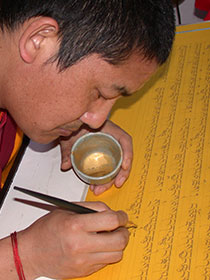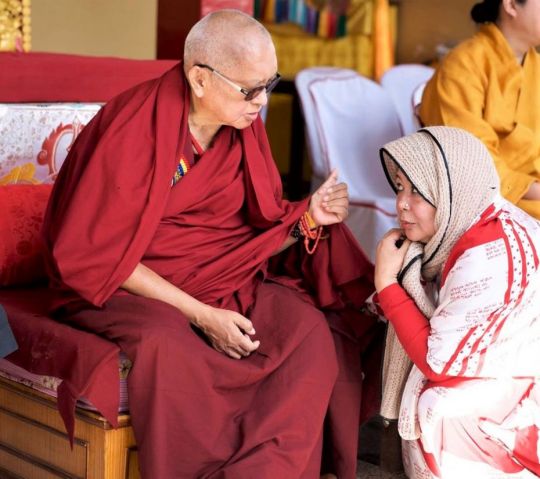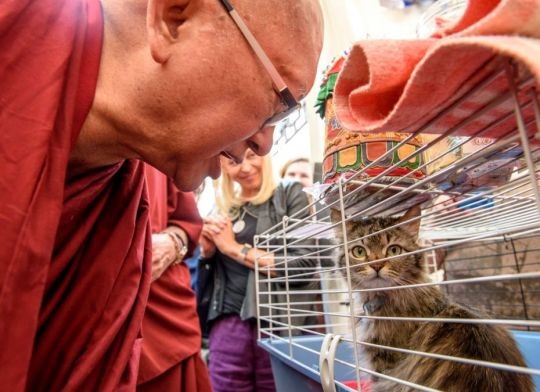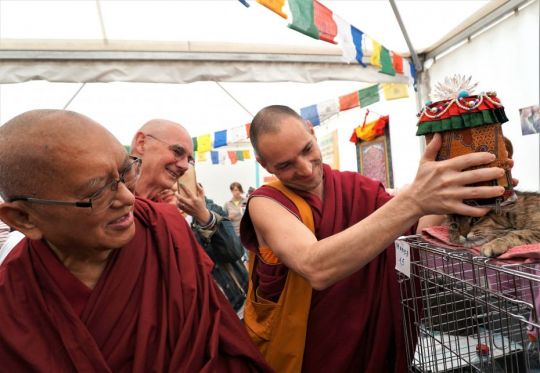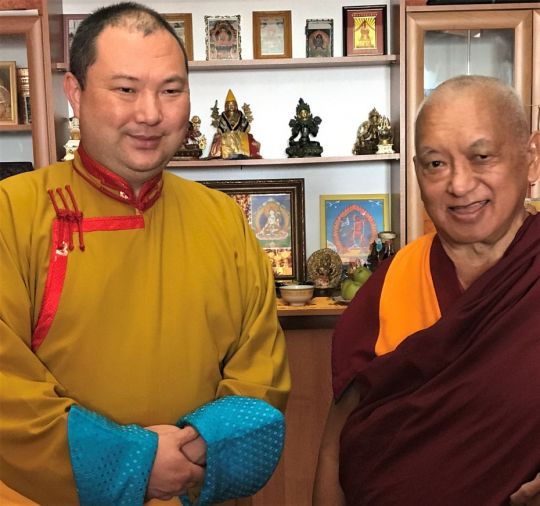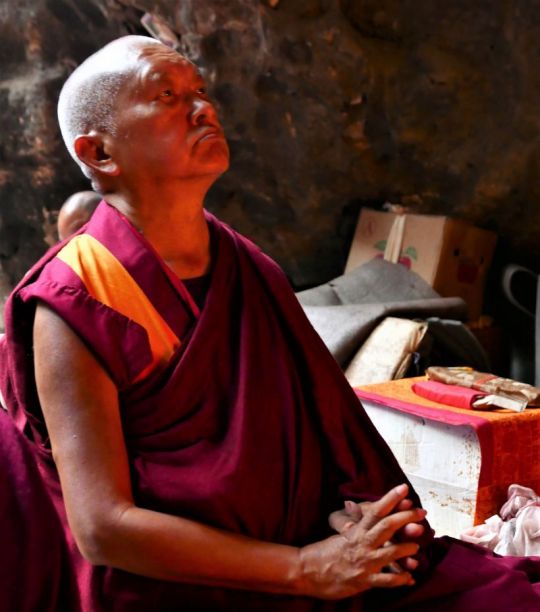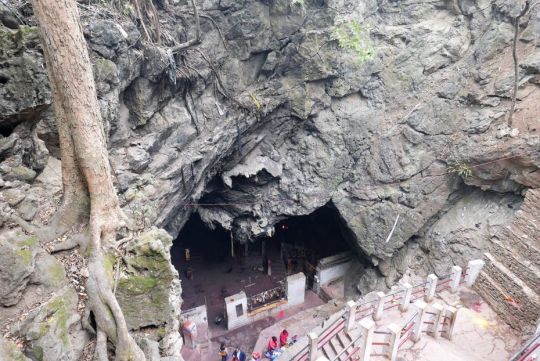- Home
- FPMT Homepage
Foundation for the Preservation of the Mahayana Tradition
The FPMT is an organization devoted to preserving and spreading Mahayana Buddhism worldwide by creating opportunities to listen, reflect, meditate, practice and actualize the unmistaken teachings of the Buddha and based on that experience spreading the Dharma to sentient beings. We provide integrated education through which people’s minds and hearts can be transformed into their highest potential for the benefit of others, inspired by an attitude of universal responsibility and service. We are committed to creating harmonious environments and helping all beings develop their full potential of infinite wisdom and compassion. Our organization is based on the Buddhist tradition of Lama Tsongkhapa of Tibet as taught to us by our founders Lama Thubten Yeshe and Lama Thubten Zopa Rinpoche.
- Willkommen
Die Stiftung zur Erhaltung der Mahayana Tradition (FPMT) ist eine Organisation, die sich weltweit für die Erhaltung und Verbreitung des Mahayana-Buddhismus einsetzt, indem sie Möglichkeiten schafft, den makellosen Lehren des Buddha zuzuhören, über sie zur reflektieren und zu meditieren und auf der Grundlage dieser Erfahrung das Dharma unter den Lebewesen zu verbreiten.
Wir bieten integrierte Schulungswege an, durch denen der Geist und das Herz der Menschen in ihr höchstes Potential verwandelt werden zum Wohl der anderen – inspiriert durch eine Haltung der universellen Verantwortung und dem Wunsch zu dienen. Wir haben uns verpflichtet, harmonische Umgebungen zu schaffen und allen Wesen zu helfen, ihr volles Potenzial unendlicher Weisheit und grenzenlosen Mitgefühls zu verwirklichen.
Unsere Organisation basiert auf der buddhistischen Tradition von Lama Tsongkhapa von Tibet, so wie sie uns von unseren Gründern Lama Thubten Yeshe und Lama Thubten Zopa Rinpoche gelehrt wird.
- Bienvenidos
La Fundación para la preservación de la tradición Mahayana (FPMT) es una organización que se dedica a preservar y difundir el budismo Mahayana en todo el mundo, creando oportunidades para escuchar, reflexionar, meditar, practicar y actualizar las enseñanzas inconfundibles de Buda y en base a esa experiencia difundir el Dharma a los seres.
Proporcionamos una educación integrada a través de la cual las mentes y los corazones de las personas se pueden transformar en su mayor potencial para el beneficio de los demás, inspirados por una actitud de responsabilidad y servicio universales. Estamos comprometidos a crear ambientes armoniosos y ayudar a todos los seres a desarrollar todo su potencial de infinita sabiduría y compasión.
Nuestra organización se basa en la tradición budista de Lama Tsongkhapa del Tíbet como nos lo enseñaron nuestros fundadores Lama Thubten Yeshe y Lama Zopa Rinpoche.
A continuación puede ver una lista de los centros y sus páginas web en su lengua preferida.
- Bienvenue
L’organisation de la FPMT a pour vocation la préservation et la diffusion du bouddhisme du mahayana dans le monde entier. Elle offre l’opportunité d’écouter, de réfléchir, de méditer, de pratiquer et de réaliser les enseignements excellents du Bouddha, pour ensuite transmettre le Dharma à tous les êtres. Nous proposons une formation intégrée grâce à laquelle le cœur et l’esprit de chacun peuvent accomplir leur potentiel le plus élevé pour le bien d’autrui, inspirés par le sens du service et une responsabilité universelle. Nous nous engageons à créer un environnement harmonieux et à aider tous les êtres à épanouir leur potentiel illimité de compassion et de sagesse. Notre organisation s’appuie sur la tradition guéloukpa de Lama Tsongkhapa du Tibet, telle qu’elle a été enseignée par nos fondateurs Lama Thoubtèn Yéshé et Lama Zopa Rinpoché.
Visitez le site de notre Editions Mahayana pour les traductions, conseils et nouvelles du Bureau international en français.
Voici une liste de centres et de leurs sites dans votre langue préférée
- Benvenuto
L’FPMT è un organizzazione il cui scopo è preservare e diffondere il Buddhismo Mahayana nel mondo, creando occasioni di ascolto, riflessione, meditazione e pratica dei perfetti insegnamenti del Buddha, al fine di attualizzare e diffondere il Dharma fra tutti gli esseri senzienti.
Offriamo un’educazione integrata, che può trasformare la mente e i cuori delle persone nel loro massimo potenziale, per il beneficio di tutti gli esseri, ispirati da un’attitudine di responsabilità universale e di servizio.
Il nostro obiettivo è quello di creare contesti armoniosi e aiutare tutti gli esseri a sviluppare in modo completo le proprie potenzialità di infinita saggezza e compassione.
La nostra organizzazione si basa sulla tradizione buddhista di Lama Tsongkhapa del Tibet, così come ci è stata insegnata dai nostri fondatori Lama Thubten Yeshe e Lama Zopa Rinpoche.
Di seguito potete trovare un elenco dei centri e dei loro siti nella lingua da voi prescelta.
- 欢迎 / 歡迎
简体中文
“护持大乘法脉基金会”( 英文简称:FPMT。全名:Foundation for the Preservation of the Mahayana Tradition) 是一个致力于护持和弘扬大乘佛法的国际佛教组织。我们提供听闻,思维,禅修,修行和实证佛陀无误教法的机会,以便让一切众生都能够享受佛法的指引和滋润。
我们全力创造和谐融洽的环境, 为人们提供解行并重的完整佛法教育,以便启发内在的环宇悲心及责任心,并开发内心所蕴藏的巨大潜能 — 无限的智慧与悲心 — 以便利益和服务一切有情。
FPMT的创办人是图腾耶喜喇嘛和喇嘛梭巴仁波切。我们所修习的是由两位上师所教导的,西藏喀巴大师的佛法传承。
繁體中文
護持大乘法脈基金會”( 英文簡稱:FPMT。全名:Found
ation for the Preservation of the Mahayana Tradition ) 是一個致力於護持和弘揚大乘佛法的國際佛教組織。我們提供聽聞, 思維,禪修,修行和實證佛陀無誤教法的機會,以便讓一切眾生都能 夠享受佛法的指引和滋潤。 我們全力創造和諧融洽的環境,
為人們提供解行並重的完整佛法教育,以便啟發內在的環宇悲心及責 任心,並開發內心所蘊藏的巨大潛能 — 無限的智慧與悲心 – – 以便利益和服務一切有情。 FPMT的創辦人是圖騰耶喜喇嘛和喇嘛梭巴仁波切。
我們所修習的是由兩位上師所教導的,西藏喀巴大師的佛法傳承。 察看道场信息:
- FPMT Homepage
- News/Media
-
- Study & Practice
-
-
- About FPMT Education Services
- Latest News
- Programs
- New to Buddhism?
- Buddhist Mind Science: Activating Your Potential
- Heart Advice for Death and Dying
- Discovering Buddhism
- Living in the Path
- Exploring Buddhism
- FPMT Basic Program
- FPMT Masters Program
- FPMT In-Depth Meditation Training
- Maitripa College
- Lotsawa Rinchen Zangpo Translator Program
- Universal Education for Compassion & Wisdom
- Online Learning Center
-
- Prayers & Practice Materials
- Overview of Prayers & Practices
- Full Catalogue of Prayers & Practice Materials
- Explore Popular Topics
- Benefiting Animals
- Chenrezig Resources
- Death & Dying Resources
- Lama Chopa (Guru Puja)
- Lama Zopa Rinpoche: Compendium of Precious Instructions
- Lama Zopa Rinpoche: Life Practice Advice
- Lama Zopa Rinpoche Practice Series
- Lamrim Resources
- Mantras
- Prayer Book Updates
- Purification Practices
- Sutras
- Thought Transformation (Lojong)
- Audio Materials
- Dharma Dates - Tibetan Calendar
- Translation Services
- Publishing Services
- Ways to Offer Support
- Prayers & Practice Materials
-
- Teachings and Advice
- Find Teachings and Advice
- Lama Zopa Rinpoche Advice Page
- Lama Zopa Rinpoche: Compendium of Precious Instructions
- Lama Zopa Rinpoche Video Teachings
- ༧སྐྱབས་རྗེ་བཟོད་པ་རིན་པོ་ཆེ་མཆོག་ནས་སྩལ་བའི་བཀའ་སློབ་བརྙན་འཕྲིན།
- Podcasts
- Lama Yeshe Wisdom Archive
- Buddhism FAQ
- Dharma for Young People
- Resources on Holy Objects
- Teachings and Advice
-
-
*If a menu item has a submenu clicking once will expand the menu clicking twice will open the page.
-
-
- Centers
-
- Teachers
-
- Projects
-
-
-
-
*If a menu item has a submenu clicking once will expand the menu clicking twice will open the page.
-
-
- FPMT
-
-
-
-
-
Be wise. Treat yourself, your mind, sympathetically, with loving kindness. If you are gentle with yourself, you will become gentle with others.
Lama Thubten Yeshe
-
-
-
- Shop
-
-
-
The Foundation Store is FPMT’s online shop and features a vast selection of Buddhist study and practice materials written or recommended by our lineage gurus. These items include homestudy programs, prayers and practices in PDF or eBook format, materials for children, and other resources to support practitioners.
Items displayed in the shop are made available for Dharma practice and educational purposes, and never for the purpose of profiting from their sale. Please read FPMT Foundation Store Policy Regarding Dharma Items for more information.
-
-
Lama Zopa Rinpoche News
19
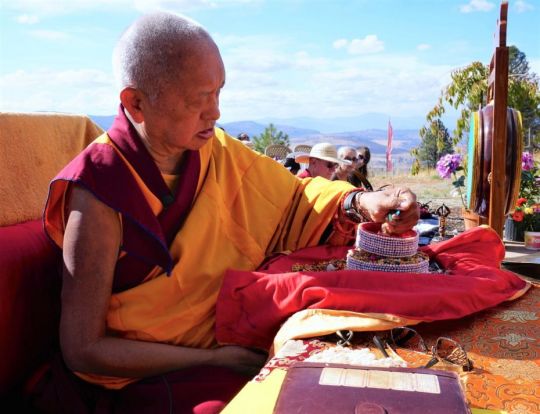
Lama Zopa Rinpoche offering a mandala, Washington State, US, October 2016. Photo by Ven. Lobsang Sherab.
What is the most important thing to remember when doing mandala offerings?
Lama Zopa Rinpoche has explained that, “Many high lamas have made comments on [the mandala offering]. The main purpose is to create merit, so it’s important that your visualization is good quality and most extensive. Otherwise, there is not much reason to do it. Lama Tsongkhapa explained mandala offerings in the Lamrim Chenmo. The key thing regarding mandala offerings is to visualize clearly and as much as possible. The essence is clear and plenty, to create merit.”
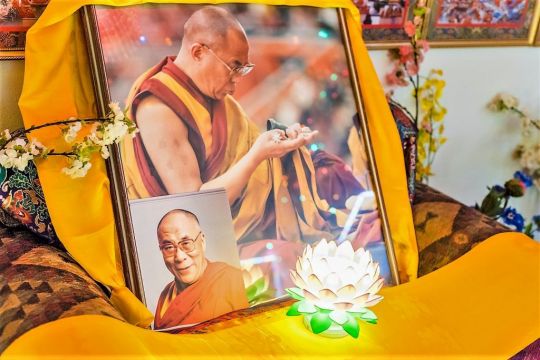
A photo of His Holiness the Dalai Lama offering a mandala, taken at the home of Lama Zopa Rinpoche at Buddha Amitabha Pure Land, Washington State, US, 2015. Photo by Chris Majors.
If we visualize well, what happens?
Rinpoche said, “All the enjoyments in all the realms is the result. … [You should] visualize offerings on every atom (like Samantabhadra) and then from each of those atoms, beams are emitted and carry mandala offerings that fill the sky and become numberless. Everything you visualize should be big, huge!”
Rinpoche concluded,”I heard that one lama takes more than an hour to visualize the mandala. This is a great lama. … The more you can visualize, the more merit you create!”
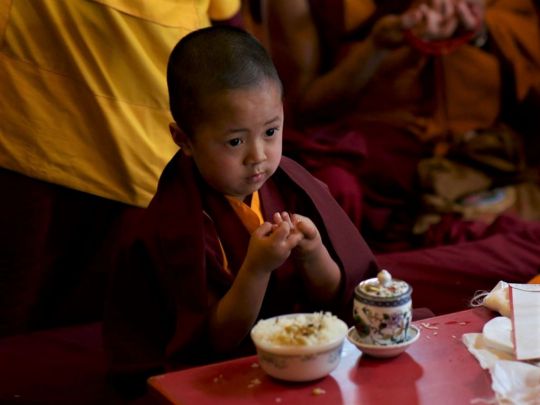
Offering a mandala at Kopan Monastery, Nepal, March 2017. Photo by Bill Kane.
Find the complete teaching here:
https://www.lamayeshe.com/advice/mandala-offerings
Lama Zopa Rinpoche is the spiritual director of the Foundation for the Preservation of Mahayana Tradition (FPMT), a Tibetan Buddhist organization dedicated to the transmission of the Mahayana Buddhist tradition and values worldwide through teaching, meditation, and community service.
- Tagged: lama zopa rinpoche, mandala, merit, offerings
12
Lama Zopa Rinpoche on Shopping

Lama Zopa Rinpoche shopping in New York City, US, 2016. Photo by Ven. Roger Kunsang.
Can shopping go along with Dharma?
In 2009, Lama Zopa Rinpoche gave some advice on how to make shopping a virtuous activity.
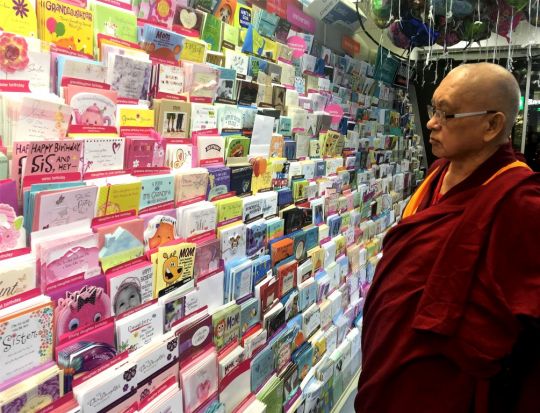
Lama Zopa Rinpoche shopping in New York City, US, 2016. Photo by Ven. Roger Kunsang.
Rinpoche said, “When you do shopping, watch and prepare your motivation. When you are in the shop, either do it to fulfill the wishes of the guru or to benefit and serve other sentient beings. The ultimate purpose is to fulfill the guru’s advice. So, you buy these things to survive so as to fulfill the wishes of the guru or benefit sentient beings. This way it becomes an antidote to attachment, becomes a virtuous activity, Dharma, and collects extensive merit.”
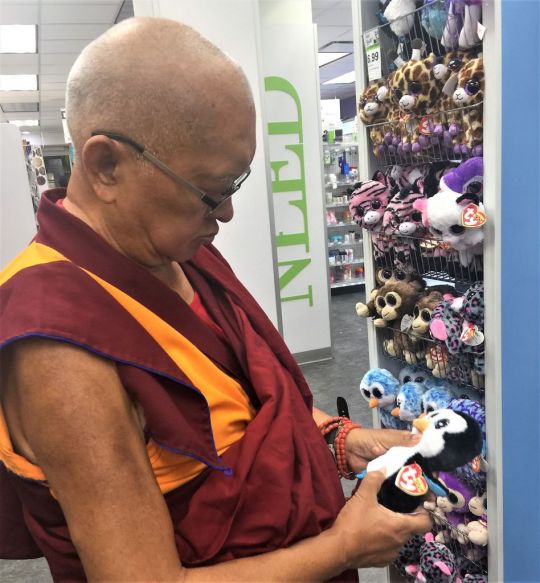
Lama Zopa Rinpoche shopping for stuffed toys in New York City, US, 2016. Photo by Ven. Roger Kunsang.
Find the original teaching here:
https://www.lamayeshe.com/advice/restaurants-and-shopping
Lama Zopa Rinpoche is the spiritual director of the Foundation for the Preservation of Mahayana Tradition (FPMT), a Tibetan Buddhist organization dedicated to the transmission of the Mahayana Buddhist tradition and values worldwide through teaching, meditation and community service.
- Tagged: attachment, lama zopa rinpoche, shopping
10
Lama Zopa Rinpoche talked in 2008 about our good fortune: being able to choose happiness. What is the source of this good fortune? Teachings on how to create the causes of happiness.
“What people believe in the world, the more common people, those who don’t have the Dharma,” he explained, “is that the cause of happiness is external: the five sense objects and external things together. But achieving that doesn’t mean they always achieve happiness, it doesn’t mean that. Only if the cause of happiness is there, then they will experience happiness. Therefore, they have a totally wrong belief, a totally wrong understanding of the cause of happiness … The actual cause of happiness is our own mind, the positive mind and positive actions.”
He went on to say that, “People who understand the cause of freedom have freedom in everyday life. For us, this time we have met the Buddhadharma and we understand, so we have freedom. By knowing karma and the mind, how happiness and suffering both have to come from the mind, we are able to stop creating suffering … and to achieve happiness.”
He added,“If we understand karma, we have freedom … We have freedom every day. No matter what activities we do with our body, speech, and mind, they become the cause of enlightenment, they become the cause to achieve the happiness of future lives and then the cause to achieve liberation from samsara and the cause to achieve enlightenment for sentient beings.”
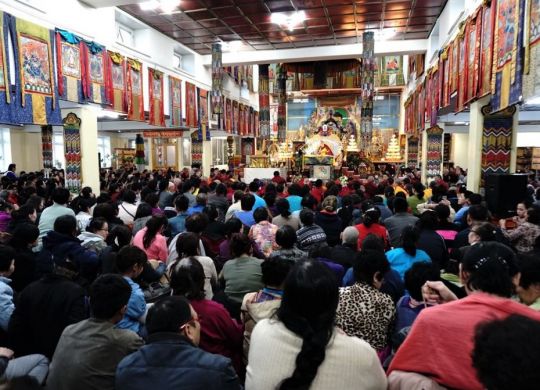
First day of Lama Zopa Rinpoche’s teachings at Idgaa Choizinling Monastery, Ulaanbaatar, Mongolia, May 2017. Photo by Ven. Lobsang Sherab.
Rinpoche concluded by saying, “Once we have understood karma, we have full freedom in our life. Whatever happiness we want to achieve is in our hands. So, we are unbelievably fortunate. We must realize how fortunate we are, how unbelievably fortunate, how unimaginably fortunate, having this wisdom, this Dharma wisdom. We are unbelievably, unbelievably fortunate. For most human beings in the world, it’s not like that.”
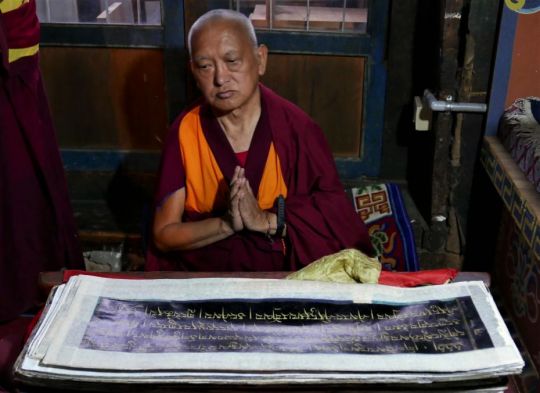
Lama Zopa Rinpoche looking at the 8,000 Verse Prajnaparamita in the gompa at Guru Rinpoche’s place of holy speech, Jangsarbu lhakhang, Paro, Bhutan, June 2016. Photo by Ven. Roger Kunsang.
Read the entire teaching here:
https://www.lamayeshe.com/article/chapter/lectures-18-19-pilgrimage-and-power-holy-objects
Lama Zopa Rinpoche is the spiritual director of the Foundation for the Preservation of Mahayana Tradition (FPMT), a Tibetan Buddhist organization dedicated to the transmission of the Mahayana Buddhist tradition and values worldwide through teaching, meditation, and community service.
5
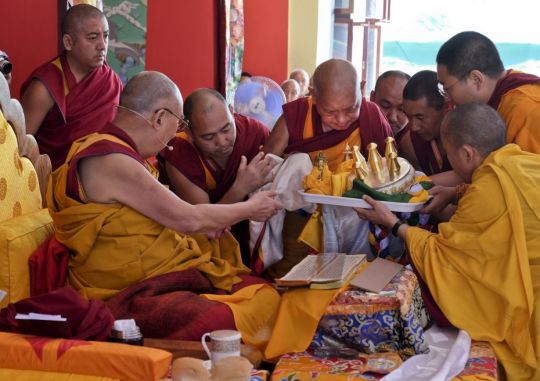
His Holiness the Dalai Lama being offered a mandala by Lama Zopa Rinpoche at the Jangchup Lamrim teachings, Tashi Lhunpo Monastery, India, December 2015. Photo by Rio Helmi/JCLRC.
On July 6, the 82nd birthday of His Holiness the Dalai Lama is being celebrated around the world by Tibetans and Western students of the Dharma. As the spiritual guide for six million Tibetans, as Lama Zopa Rinpoche’s guru, as a recipient of the Noble Peace Prize, and as a promoter of each individual’s universal responsibility toward humankind and the environment, His Holiness serves as a living symbol for world peace.
A collection of long life prayers composed by His Holiness’s late tutors His Holiness Ling Rinpoche and His Holiness Trijang Rinpoche is available for students to recite on this special day. Below is a short extract:
O our gurus, and your line of lamas, for whom we have the deepest gratitude,
You who are the repository of the three: secret powers of body, speech, and mind of innumerable buddhas,
Who manifest in a miraculous way to each devotee according to his capacity,
To you, who are the wish-fulfilling gems, the source of all virtues and good qualities,
We offer our prayers with intense devotion
That our protector of the great land of snows,
Tenzin Gyatso, upholder of the Dharma, the great ocean,
May live for a hundred eons.
Pour on him your blessings
That his aspirations may be fulfilled. …
Lama Zopa Rinpoche is a devoted student of His Holiness and service to His Holiness is an important aim of FPMT. For over twenty years, FPMT International Office has taken responsibility to help offer a long life puja to His Holiness every year on behalf of the entire organization. Long life pujas, in addition to maintaining harmony between students and following our teachers’ advice, is an important means for accumulating the merit needed for our precious gurus to stay in the world for a long time.
We wish His Holiness’s a very happy and healthy birthday. May all His Holiness’s holy wishes come into fruition immediately and may he remain and teach us for a very long time!
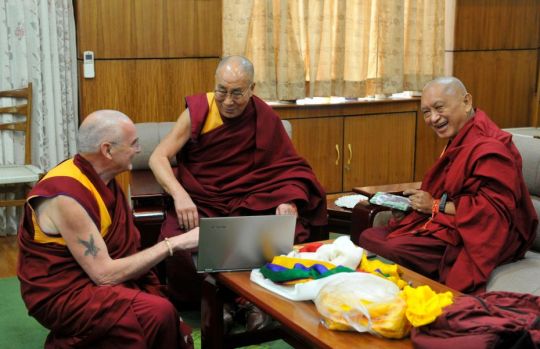
His Holiness the Dalai Lama with Lama Zopa Rinpoche and Ven. Roger Kunsang, Dharamsala, India, March 2015. Photo by the Office of His Holiness the Dalai Lama.
A variety of devotional images of His Holiness the Dalai Lama are available through the Foundation Store:
https://shop.fpmt.org/Cards-Posters_c_529.html
More information, photos and updates about FPMT spiritual director Lama Zopa Rinpoche can be found on Rinpoche’s webpage. If you’d like to receive news of Lama Zopa Rinpoche via email, sign up to receive FPMT News.
- Tagged: his holiness the dalai lama
26
Serving the Guru [Video]
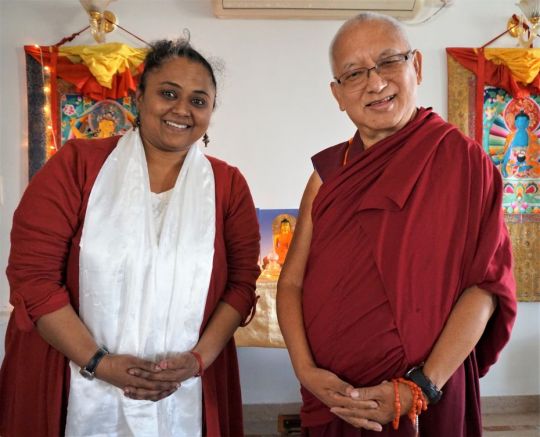
Lama Zopa Rinpoche and Deepthy Chandrashekhar, FPMT India national coordinator, Bangalore, India, December 2016. Photo by Ven. Lobsang Sherab.
The Buddha guides us, Lama Zopa Rinpoche says, through the guru, and the guru is like a magnifying glass through which we receive the Buddha’s blessings. In the video below, Lama Zopa Rinpoche talks about the importance of the guru.
And how should we serve the guru? Lama Zopa Rinpoche discussed the question in his book The Heart of the Path.
First comes “devot[ing] ourselves correctly to the virtuous friend with thought,” said Rinpoche, “and we then naturally devote ourselves correctly with action … Correct devotion to the guru with action comes easily as a result of correct devotion with thought.” That means, he explained, “seeing the guru as Buddha.”
Referring to serving the guru directly and working in Dharma centers, he commented, “Doing any work that our guru has advised us to do has great benefit, making our life highly meaningful.”
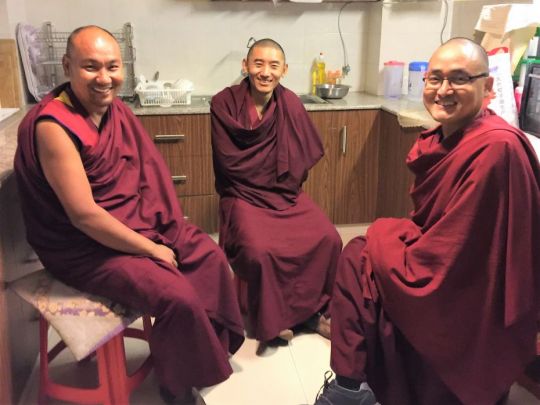
Lama Zopa Rinpoche’s attendants Ven. Tendar, Ven. Sangpo, and Ven. Sherab in the kitchen at Kopan Monastery, Nepal, November 2016. Photo by Ven. Roger Kunsang.
He added, “Even if we’re not doing the actual work of teaching Dharma, by working in a Dharma center we are providing the conditions for many other people to practice the holy teachings and follow the infallible path to enlightenment. If we frequently think about this in our everyday life, our mind will be very happy.”
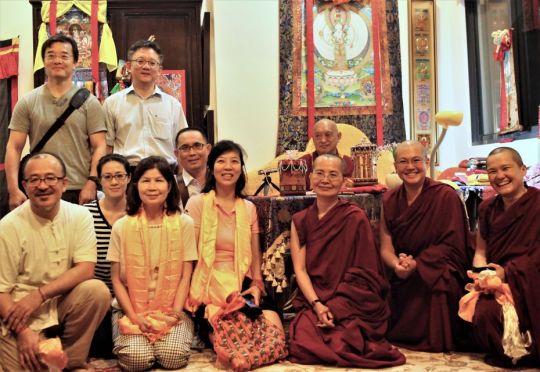
Board of FPMT Taiwan meeting with Lama Zopa Rinpoche, May 2016. Photo by Ven. Lobsang Sherab.
And referring to other activities, Rinpoche said, “We should constantly remember our guru in our heart and do our work for him. This itself is guru yoga practice. All the work we do from morning until night then becomes Dharma practice. It is also enjoyable and each day we are happy!”
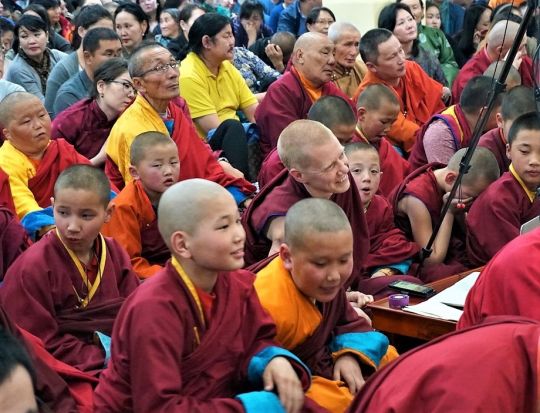
With young helpers, Ven. Holly Ansett livestreams Lama Zopa Rinpoche’s teachings at Idgaa Choizinling Monastery, Mongolia, May 2017. Photo by Ven. Lobsang Sherab.
The short video below is an excerpt from Rinpoche’s teachings at the 2016 Light of the Path retreat.
Watch the video of Lama Zopa Rinpoche discussing the importance of the guru on YouTube:
https://youtu.be/Dv21rTAgWiQ
Read the full teaching on serving the guru in chapter 15 of Lama Zopa Rinpoche’s book The Heart of the Path, available at the Foundation Store:
Hard copy: https://shop.fpmt.org/Heart-of-the-Path–Hard-Copy_p_814.html
Ebook: https://shop.fpmt.org/Heart-of-the-Path-eBook_p_2360.html
The complete teachings from the 2016 Light of the Path retreat can be found here, including links to the transcript, MP3s, and translations:
https://fpmt.org/media/streaming/teachings-of-lama-zopa-rinpoche/light-of-the-path-teachings-2016/
Lama Zopa Rinpoche is the spiritual director of the Foundation for the Preservation of Mahayana Tradition (FPMT), a Tibetan Buddhist organization dedicated to the transmission of the Mahayana Buddhist tradition and values worldwide through teaching, meditation, and community service
21
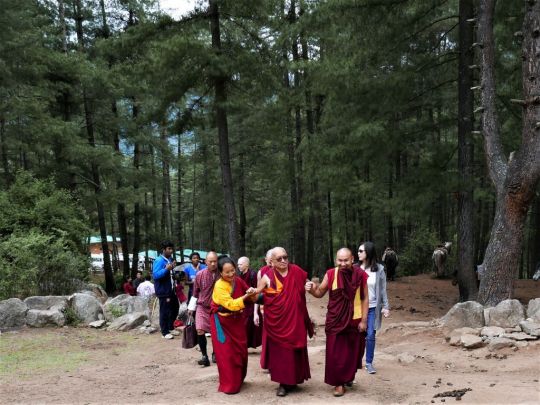
Lama Zopa Rinpoche and Khadro-la (Rangjung Neljorma Khadro Namsel Drönme) in the woods at the base of the trail to Taktsang Monastery, Bhutan, May 2016. Photo by Ven. Roger Kunsang.
Lama Zopa Rinpoche has commented several times on environmental issues, including climate change. What has he said?
In 2006, Rinpoche, concerned about climate change, saw the film An Inconvenient Truth, and made the following comments:
“Every sentient being, regardless of religion or nationality, including creatures of the land and sea, all [want] to be free of the impure substances, pollution, and the atomic bomb that are harmful to all of us and the environment. … This includes beings such as nagas and worldly gods who are also involved in the elements, and who are harmed and even destroyed due to these man-made pollutions, harmful chemicals, and other things that are damaging the earth and air. [Those] who think only of personal profit without consideration for others and the environment are causing great danger to all of us—the country we live in and this whole world …
“Your happiness depends on others, and others’ happiness depends on you. We all have to live in this world, so we need to be harmonious and happy in a healthy way. No matter who you are or where you are, we all have a responsibility to protect this world.”
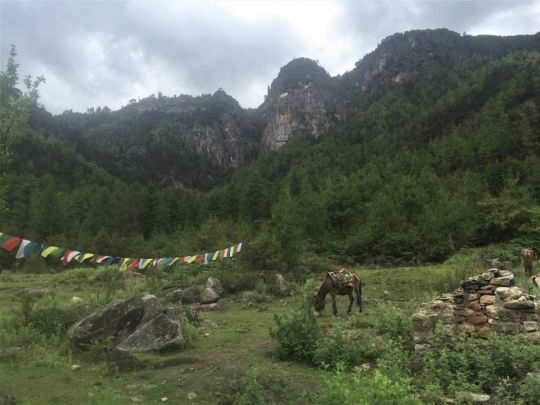
The view towards Taktsang Monastery in the mountains of Bhutan, June 2016. Photo by Ven. Roger Kunsang.
Rinpoche added in a letter to a student in 2006 that “global warming must also be related to there being a lot of factories. I think smoke from certain materials, certain bad and impure substances, affect global warming. … We must try and abandon the ones that are proved to affect global warming. From one’s own side, we should try to do this and make less pollution, then that’s our contribution to peace, without adding to the destruction of the world …”
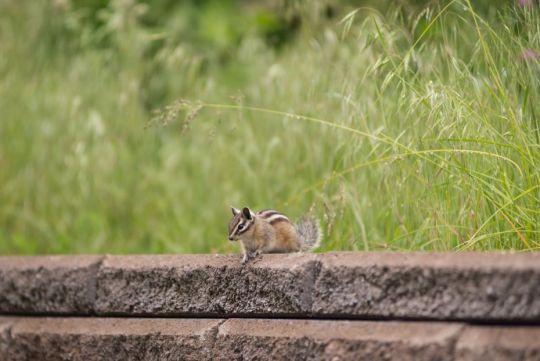
Chipmunk at Buddha Amitabha Pure Land, Washington State, US, June 2015. Photo by Chris Majors.
In 2009, Rinpoche shared some additional thoughts on climate change. He said, “Regarding global warming, usually the real cause, karma, isn’t talked about. The reality is: nothing happens without relating to the mind. People think, ‘This is a natural disaster,’ but it doesn’t happen without a cause, and the main cause is karma … of course, there are conditions, such as pollution from cars, etc., that we commonly understand. But we have to understand there IS a reason, and that is our past negative thoughts and actions. … We don’t normally talk of karma in a general situation regarding the environment, but it is important to educate people.”
In conclusion, Rinpoche noted, “Regarding the environment, anything well proven scientifically is worth following through. [Nevertheless], the main thing is to understand how things come from the mind, how things are dependent arisings, how things are the consequence of past actions. So, the conclusion is that those people undertaking retreat, serious meditation, etc. can help the environment, can bless the earth.”
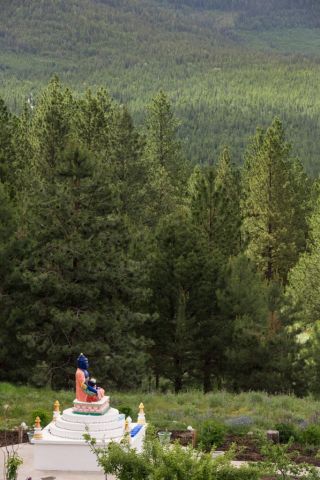
Buddha Amitabha Pure Land, where Lama Zopa Rinpoche often stays, Washington State, US, 2015. Photo by Chris Majors.
Lama Zopa Rinpoche is the spiritual director of the Foundation for the Preservation of Mahayana Tradition (FPMT), a Tibetan Buddhist organization dedicated to the transmission of the Mahayana Buddhist tradition and values worldwide through teaching, meditation and community service.
- Tagged: climate change, environment, karma, lama zopa rinpoche
19
During Lama Zopa Rinpoche’s May-June 2017 visit to Russia, Rinpoche took an entire day—May 31—to bless animals. The animal blessing was organized and hosted by Save Tibet Russia. It was well attended, with hundreds of people and animals in attendance: cats and dogs of course, but also tarantulas, birds, rodents, and snakes. Cats from a local cat shelter were brought in as well, in hopes some homes could be found for them, and Rinpoche blessed all of the shelter cats. It was reported that several cats found new homes.
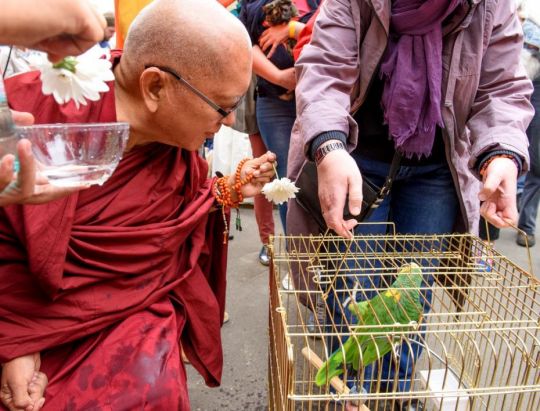
Lama Zopa Rinpoche blessing animals and birds, Moscow, Russia, May 2017. Photo by Renate Alyaudinov.
During the two hours Rinpoche spent at the event, he gave a short but compelling teaching on the whole path to enlightenment, as well as oral transmissions of mantras. He also recited mantras on a loudspeaker so that the animals would hear them from him and receive the transmission. The organizers had set up an altar just the way Rinpoche likes them, with the Kangyur, relics, and statues on it. After the blessing and the mantras, the animals were all taken around it to absorb its blessings. Then Rinpoche blessed all the animals with blessed water and relics he had with him, as well as a prayer wheel. The heartwarming event was livestreamed.
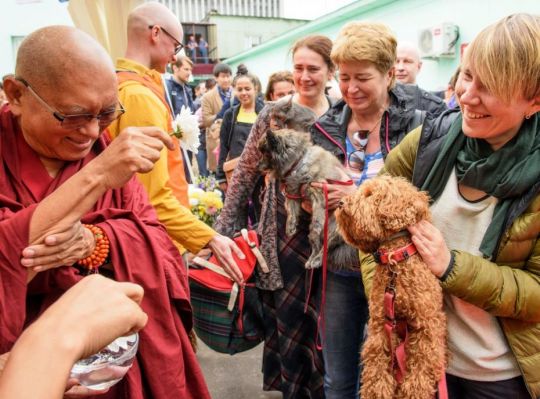
Lama Zopa Rinpoche blessing dogs while other animals wait their turn, Moscow, Russia, May 2017. Photo by Renate Alyaudinov.
Early in his teaching at the event, Rinpoche explained the importance of both morality and charity, saying, “Why do we have a human rebirth? Why? Not animal rebirth, why do we have a human rebirth this time? Especially the perfect human rebirth … Why we are living in a house and have food, and clothing, and enjoyments, that is because in past life we made charity … The omniscient one explained in the teachings that from pure morality comes higher rebirth: … having a human shape of body, that comes from pure morality. And then all wealth, all enjoyments come from charity.” One form of charity is the giving of mantras and blessings.
Rinpoche explained the benefits of blessing animals during his teaching, saying, “The Buddha explained all the benefits of mantra… The mantra is to liberate them from suffering. Just having heard mantras plants the seeds of a fully awakened mind, the total cessation of obscurations and the completion of realizations; mantras plant seeds for that.”
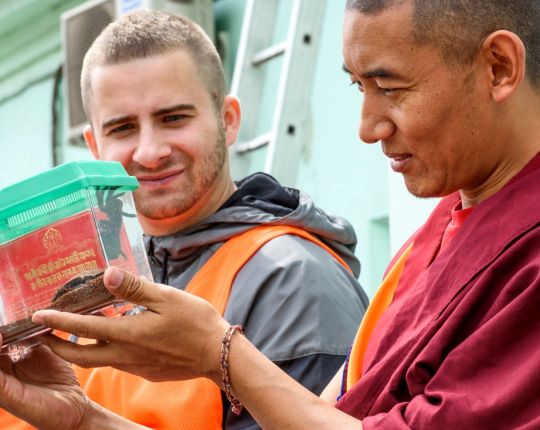
Ven. Sangpo, Lama Zopa Rinpoche’s attendant, examines an unusual pet during Rinpoche’s animal blessing event, Moscow, Russia, May 2017. Photo by Renate Alyaudinov.
On the Chenrezig mantra in particular, Rinpoche added, “Chenrezig, Compassion Buddha’s mantra, this mantra OM MANI PADME HUM … in one text it is mentioned, the benefits of Chenrezig mantra, if you see Chenrezig mantra OM MANI PADME HUM it becomes your last rebirth in samsara. If you see OM MANI PADME HUM therefore in Solu Khumbu [where] it is carved in rock, you come up this way and go down this way so [walking] becomes circumambulation, rocks are carved with OM MANI PADME HUM and many different mantras, so much unbelievable benefit to the people and even animals, therefore so many rocks are carved…”
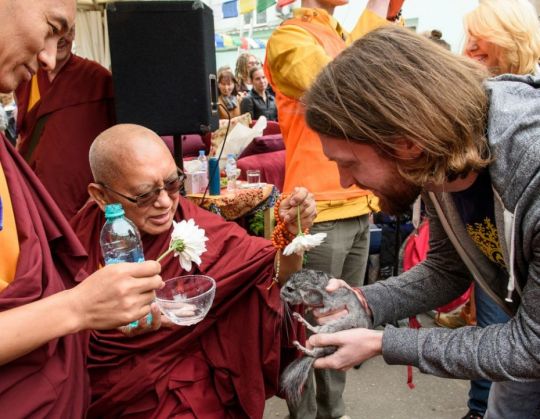
Pets come in all shapes and sizes… Lama Zopa Rinpoche blessing animals, Moscow, Russia, May 2017. Photo by Renate Alyaudinov.
Rinpoche continued, saying, “[The mantra] plants seeds of enlightenment in their minds, the kind, precious mother dogs, cats, all these. You visualize Chenrezig like a mountain, a snow mountain, then nectar and beams are emitted with loving kindness to you, to your mother precious dogs, cats, all sentient beings, then to those who are sick, who are dying now, think that Chenrezig sends beams, nectar and beams, to you and to precious dogs, cats, and people who are sick or dying, and to all the six realm sentient beings. Think that.”

This blue-eyed beauty seems quite happy to receive a blessing, Moscow, Russia, May 2017. Photo by Ven. Lobsang Sherab.
During his evening teaching later, Rinpoche talked about the importance of caring for animals and being kind to them. He said that, as Buddhists having animals, it is important that we make their lives beneficial, giving them Dharma names, taking them around holy objects, blessing them with mantras, and so on.
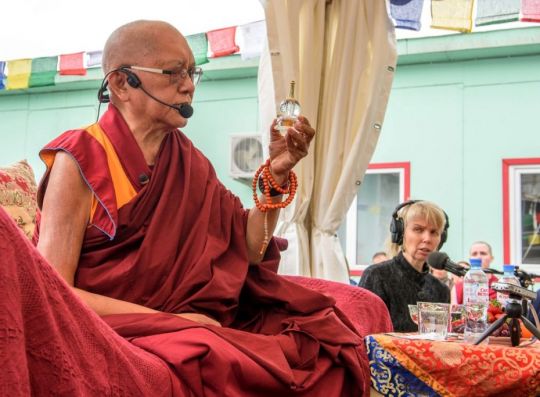
Lama Zopa Rinpoche during the animal blessing event, Moscow, Russia, May 2017. Photo by Renate Alyaudinov.
According to Rinpoche in his book Liberating Animals from the Danger of Death, sentient beings can experience purification of their karma and avoid the lower realms in the future as a result of such practices. Rinpoche says there: “When the Buddha gave teachings to 500 swans in a field, in their next life they were born as human beings. They became monks and all became arya beings, able to achieve the cessation of suffering and the true path. So the result is unbelievable, just by hearing Dharma words.”
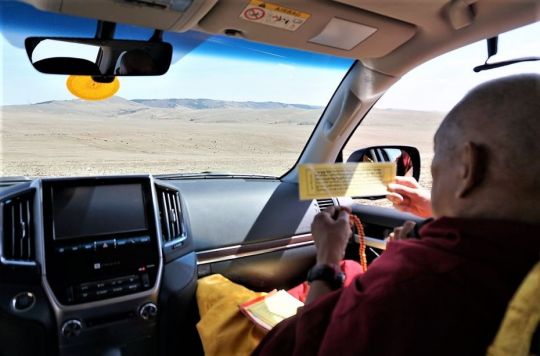
Lama Zopa Rinpoche blessing animals with mantras on the way to Darkhan, Mongolia, May 2017. Photo by Ven. Lobsang Sherab.
See more photos of Lama Zopa Rinpoche’s visit to Russia here:
https://photos.app.goo.gl/pGb9sPVNFRntUESB6
Watch videos and find transcripts from Lama Zopa Rinpoche’s teaching in Russia:
https://fpmt.org/media/streaming/teachings-of-lama-zopa-rinpoche/lama-zopa-rinpoche-teachings-in-russia-2017/
Benefiting animals is one of Lama Zopa Rinpoche’s Vast Visions for FPMT. Read about it here:
https://fpmt.org/fpmt/vast-vision/#animal
and: https://fpmt.org/tag/animals/
Get Liberating Animals from the Danger of Death as an e-book or in a print copy from the Foundation Store and support FPMT International Office:
https://shop.fpmt.org/Liberating-Animals-eBook_p_2334.html.
Lama Zopa Rinpoche is the spiritual director of the Foundation for the Preservation of Mahayana Tradition (FPMT), a Tibetan Buddhist organization dedicated to the transmission of the Mahayana Buddhist tradition and values worldwide through teaching, meditation and community service.
- Tagged: animals, lama zopa rinpoche, mantras, russia
14

Lama Zopa Rinpoche at the teaching venue in Moscow, Russia, May 2017. Photo by Ven. Lobsang Sherab.
Lama Zopa Rinpoche gave a week of evening teachings in Moscow, May 27 through June 3. Ganden Tendar Ling, the FPMT center in Moscow, organized the teaching event, which was held in a large public hall and livestreamed.
Rinpoche began his first day of teachings on the topic of death and dying, drawing from his book How to Enjoy Death. The Russian edition of this book was officially launched during his visit.
Rinpoche ended up teaching on this essential topic for most of the three-day period, in place of the planned Kadampa teachings. Ven. Holly Ansett reported that this was “an exceptional teaching on integrating the five powers in this lifetime as well as at the time of death.” She added that on the last day he taught one verse from the Kadampa teachings.
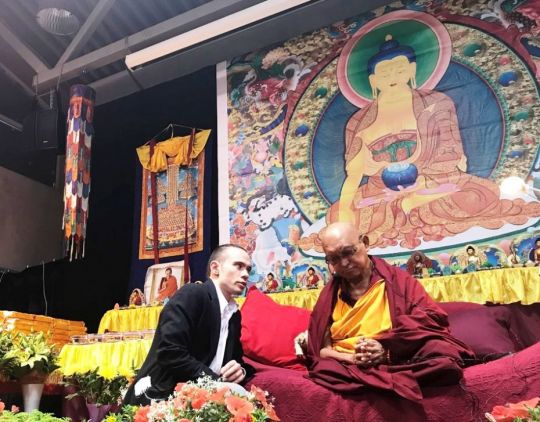
Lama Zopa Rinpoche during teachings in Moscow, listening to question from audience being translated from Russian to English, Russia, May 2017. Photo by Ven. Roger Kunsang.
Approximately 700 people attended the first day of teaching. On the second day, a residential retreat began, led by Ven. Olivier Rossi, Ganden Tendar Ling’s visiting teacher. This gave attendees an opportunity to go deeper into practice with Ven. Olivier, who led prayers and meditations, conducted Q&A sessions, and reviewed the material taught by Rinpoche. Between 500 and 600 people attended the retreat and the following days of Rinpoche’s teachings.
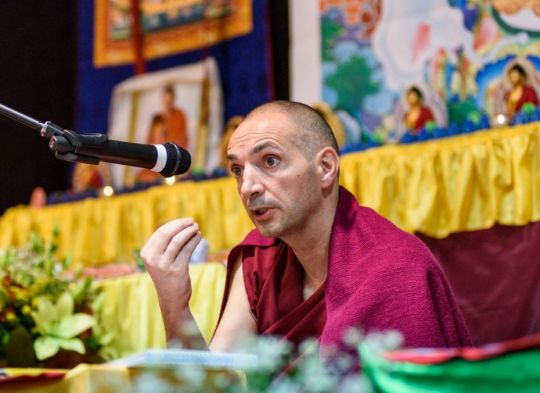
Ven. Olivier Rossi explaining the teachings, Moscow, Russia, May 2017. Photo by Renate Alyaudinov.
From June 1 to June 3, Rinpoche gave preparatory teachings and conducted a Medicine Buddha initiation. While Rinpoche was in Moscow, the city experienced a severe thunderstorm with hurricane-strength winds, which was responsible for the deaths of sixteen people. Hundreds of trees were blown down, and one smashed a car in front of the venue where Rinpoche was teaching. There were no injuries among those attending the teachings.
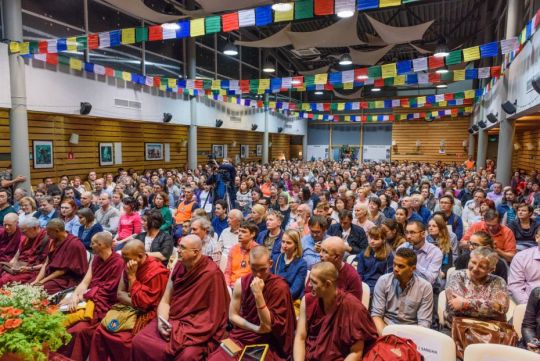
The first day of Lama Zopa Rinpoche’s teachings in Moscow, organized by Ganden Tendar Ling, Russia, May 2017. Photo by Renate Alyaudinov.
Rinpoche walked each day both ways between the venue where he taught and the Christian monastery where he was staying. It is a route where there are beggars, and Rinpoche made offerings to them every day with great respect, holding out his gifts with both hands. To each person, he requested that they use the money for food and not alcohol. Sometimes he offered food directly. The beggars quickly recognized Rinpoche and became happy every time they saw him. And people from the retreat also began giving to the beggars because Rinpoche, in one of his teachings, said how important it was to help people in need.
More than fifty volunteers contributed to making the week of teachings with Rinpoche a success. According to Ven. Holly Ansett, “The whole event was really well organized. Everything worked out very well—very successful, and very harmonious!”
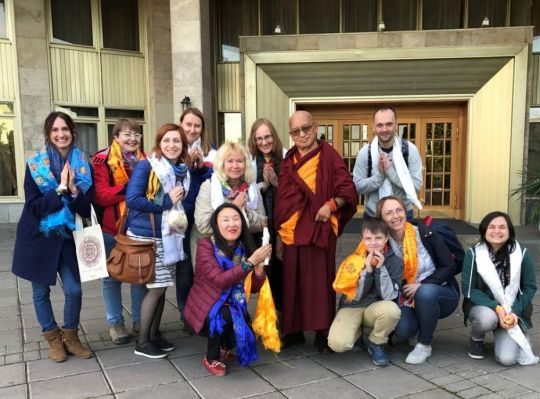
Rinpoche and students in Moscow, including Elena Bartanova from St. Petersberg, coordinator of Aryadeva Study Group, Russia, May 2017. Photo by Ven. Roger Kunsang.
Watch videos and find transcripts from Lama Zopa Rinpoche’s teaching in Russia:
https://fpmt.org/media/streaming/teachings-of-lama-zopa-rinpoche/lama-zopa-rinpoche-teachings-in-russia-2017/
Lama Zopa Rinpoche is the spiritual director of the Foundation for the Preservation of Mahayana Tradition (FPMT), a Tibetan Buddhist organization dedicated to the transmission of the Mahayana Buddhist tradition and values worldwide through teaching, meditation, and community service.
- Tagged: how to enjoy death, lama zopa rinpoche, russia
12
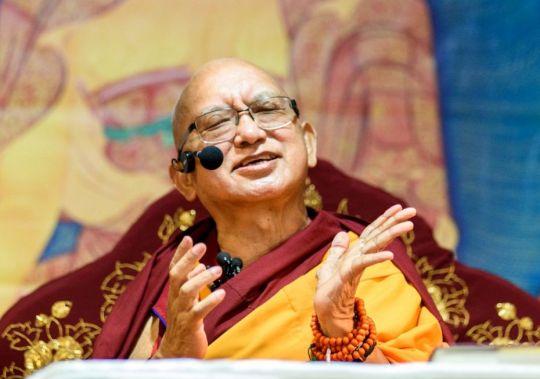
Lama Zopa Rinpoche at the second day of his teachings in Moscow organized by Ganden Tendar Ling. Russia, May 2017, Photo by Renat Alyaudinov.
While Lama Zopa Rinpoche was in Kalmykia, Russia, in May 2017, a traditionally Buddhist area of Russia settled centuries ago by migrants from Mongolia, he stayed at the former home of Geshe Tenzin Dugda (Tib.’brug-sgra), a Tibetan geshe who lived in Kalmykia for many years. Lama Zopa Rinpoche had known Geshe Dugda in the 1960s.

Geshe Tenzin Dugda in Kalmykia, 2011. Photo courtesy of kalmykia.eu.
Geshe Dugda (1938-2012) was part of the first generation of Tibetan exiles who fled Tibet in 1959 to follow His Holiness the Dalai Lama into exile. He left Tibet at the age of 20, and later helped rebuild Drepung Gomang monastery in the southern Indian state of Karnataka. After years of dedicated work rebuilding the monastery as well as completing his studies, he received the geshe lharampa degree, the highest academic qualification in the Gelugpa tradition. In 1995, Geshe Dugda moved to Kalmykia on the advice of His Holiness the Dalai Lama, becoming the first geshe in the small republic. He spent 17 years helping to revive Buddhism in Kalmykia, including building temples and bestowing numerous teachings and initiations. He gained large numbers of Dharma students, not only from Kalmykia, but also from other regions of Russia. He continues to be revered in Kalmykia for his warmth and kindness as well as his contributions to the restoration of Buddhism. When Geshe Dugda died, he remained on his meditation seat for four days.
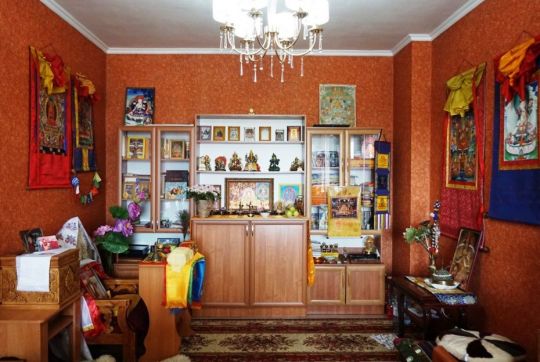
The house where Lama Zopa Rinpoche stayed in Elista, where Geshe Dugda lived. This is his altar. Elista, Kalmykia, Russia, May 2017. Photo by Ven. Lobsang Sherab.
Lama Zopa Rinpoche spoke about Geshe Dugda on May 30, 2017, during his teachings in Moscow, mentioning that Geshe Dugda had been present when Rinpoche and Lama Yeshe first met Zina Rachevsky in Ghoom, near Darjeeling, India. Here is what Rinpoche said:
There were two monasteries in Ghoom, one built by the Indian government, I don’t know the story, and the one where the monks who came from Tibet lived. One time my teacher, Lama Yeshe, was there in the room with my teacher, other teacher, who helped me in Tibet become a monk at Domo Geshe’s monastery and … brought me to India.
Later on, one monk who lived in Kalmykia and taught, was leading vinaya practice, reviving sojong in the monastery, he taught Dharma for so many years in Kalmykia, he was there, he spoke English few words, he thought the lady was my friend, her name was Princess Zina Rachevsky… [Kopan] started from her. The monk Dugda opened the door a little bit, saying, “Oh, here is your friend”. She came with blond hair, wearing a Tibetan sweater sold at the Darjeeling bus station, simple sweater, blonde hair, she came inside. Actually she didn’t come for us, came for Domo Geshe who had passed away, because she read Lama Govinda book, three books, he went in Tibet and met Domo Geshe, told his story, so she came to look for Domo Geshe.
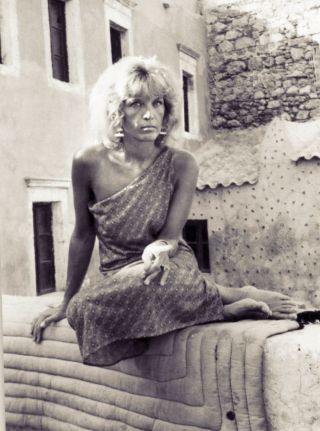
Zina Rachevsky, possibly 1967. (Photo used with permission of the estate of Zina Rachevsky.)
But Dugda, the monk, misunderstood, and thought she was my friend. Lama Yeshe put big mug, then big kettle, then offered full, she drank, that day she drank completely. Since from that time for many years I never saw her drink Tibetan [butter] tea … she came for one hour to discuss, I knew some English words and I tried to translate for Lama Yeshe. Then after one month she invited us to Darjeeling to her house … nine months we lived like that, then she went to Sri Lanka, from Buxa, we were supposed to go to Sri Lanka to start a Dharma center, but that time relation not good with India so we didn’t go. Then Lama said go to Nepal, then started like that Kopan Monastery, Lama built Kopan and I built Lawudo at the same time. From there we started one month course. … This is because we met the first student, Princess Zina Rachevsky … .
Started from Geshe Dugda who lived in Kalmykia, taught many students, he died two or three years ago, he would have been so happy to meet me in Kalmykia but he died before I came. I felt sorry about that.
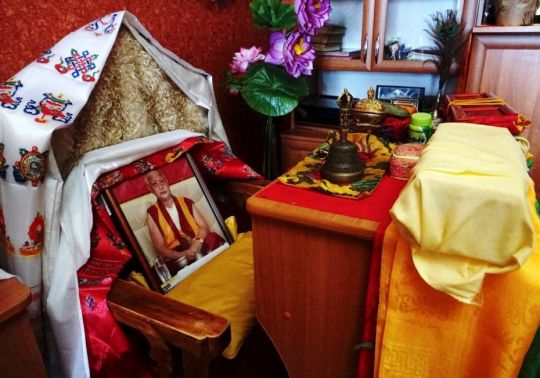
The meditation seat of Geshe Tenzin Dugda where he sat in meditation after passing away in 2012. Elista, Kalmykia, Russia, May 2017. Photo by Ven. Lobsang Sherab.
Watch videos and find transcripts from Lama Zopa Rinpoche’s teaching in Russia:
https://fpmt.org/media/streaming/teachings-of-lama-zopa-rinpoche/lama-zopa-rinpoche-teachings-in-russia-2017/
Lama Zopa Rinpoche is the spiritual director of the Foundation for the Preservation of Mahayana Tradition (FPMT), a Tibetan Buddhist organization dedicated to the transmission of the Mahayana Buddhist tradition and values worldwide through teaching, meditation, and community service.
- Tagged: geshe dugda, kalmykia, russia, zina rachevsky
7
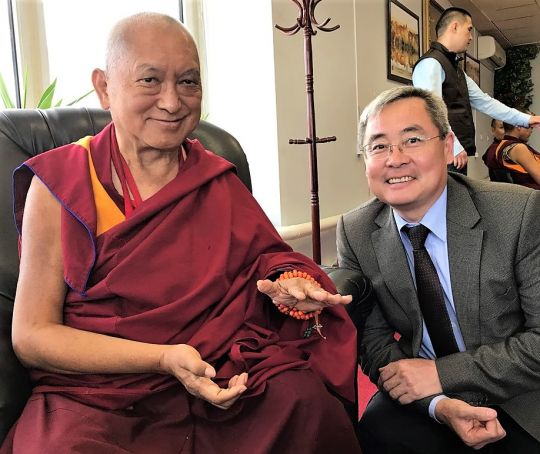
Lama Zopa Rinpoche with the Minister of Culture of Kalmykia, Hondor Badmaevich, Kalmykia, Russia, May 2017. Photo by Ven. Roger Kunsang.
From May 20 to 24, 2017, Lama Zopa Rinpoche taught in Elista, the capital of the Republic of Kalmykia, an autonomous region within Russia. Rinpoche taught on Atisha’s Lamp of the Path and gave two initiations. He also attended performances of traditional music and dance (see videos below).
Kalmykia is a Buddhist area whose people are descendants of migrants from Mongolia. Rinpoche was hosted there by Telo Rinpoche, the spiritual leader of the Kalmyk people, who organized Rinpoche’s visit and teachings. American-born tulku Telo Rinpoche has been active in the reestablishment of Buddhism in Kalmykia since being chosen as its head lama in 1992. He also serves as the honorary representative of His Holiness the Dalai Lama in Russia.
Lama Zopa Rinpoche was greeted with great warmth and respect as soon as he crossed the border into the small republic. A group of Kalmyks, including a geshe, ordained Sangha, and numerous people in local costume, had driven for several hours to welcome him to Kalmykia and offer him tea. Rinpoche also received a grand welcome when he arrived in the capital, Elista.
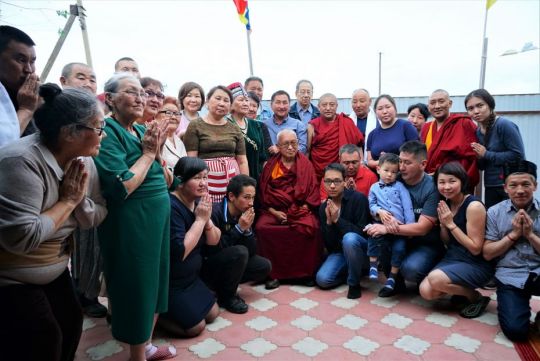
After lunch on the way to Elista, Rinpoche posed for photos with the family who offered lunch and others, Kalmykia, Russia, May 2017.
In Elista, Rinpoche stayed at the former home of the late Geshe Tenzin Dugda (Tib.’brug-sgra), who passed away in 2012. Geshe Dugda, born in Tibet in 1938, moved to Kalmykia in 1995 at His Holiness’s request, and played an important role in re-establishing Buddhism there.
Rinpoche gave teachings in a temple built in Elista in 2005 called the Golden Abode of the Buddha Shakyamuni, one of the largest Buddhist temples in Europe.
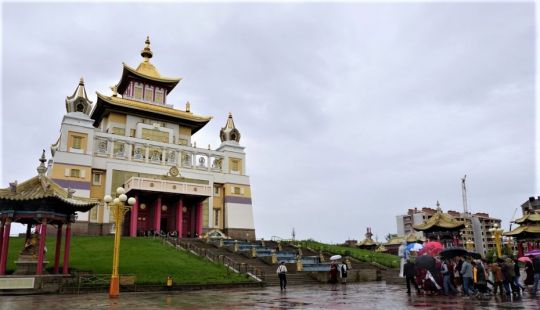
Lama Zopa Rinpoche and others approach the Golden Abode of Shakyamuni Buddha, the temple in Elista, Kalmykia, Russia, May 2017. Photo by Ven. Lobsang Sherab.
Rinpoche’s assistant, Ven. Roger Kunsang, reported that the visit to Kalmykia went very well, with more than a thousand people attending teachings and initiations, including the Kalmyk minister of culture. Kalmyk attendees were deeply grateful for Rinpoche’s visit and expressed enthusiastic devotion for him, as well as requesting him to return as soon as possible. Rinpoche mentioned that he would like to have a 100 million mani retreat take place regularly in Kalmykia.
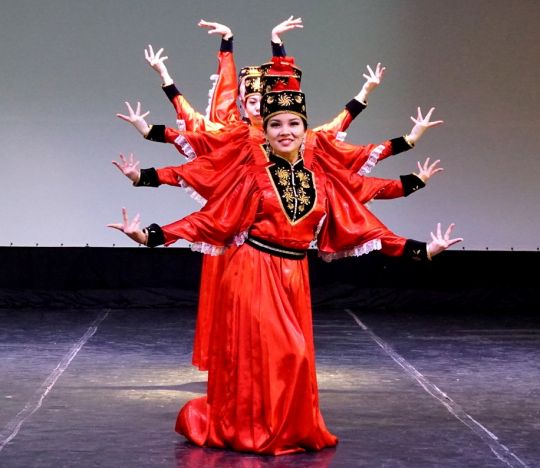
Kalmyk dance offered to Lama Zopa Rinpoche, Elista, Kalmykia, Russia, May 2017. Photo by Ven. Lobsang Sherab.
Also while in Elista, Rinpoche enjoyed a beautiful cultural dance and song offering (see videos below). Afterwards, Rinpoche blessed all the dancers and musicians as well as all who were in the theater for the performance.
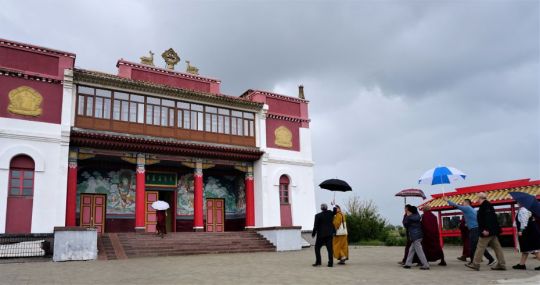
Lama Zopa Rinpoche visiting the older temple in Elista, where the monks live, Kalmykia, Russia, May 2017. Photo by Ven. Lobsang Sherab.
Kalmykia is in the southwest of the European part of Russia, north of Georgia and bordering the Caspian Sea. There are approximately 150-200,000 ethnic Kalmyks. Telo Rinpoche has been working there to restore Buddhism—suppressed for decades—since becoming head lama in 1992. There are now many Buddhist temples in Kalmykia, and numerous young Kalmyk men are being trained at Tibetan monasteries in India.
The Maitreya Project Heart Shrine Relic Tour visited Kalmykia in 2008. Read more about that visit, and the recent history of Buddhism in Kalmykia, here.
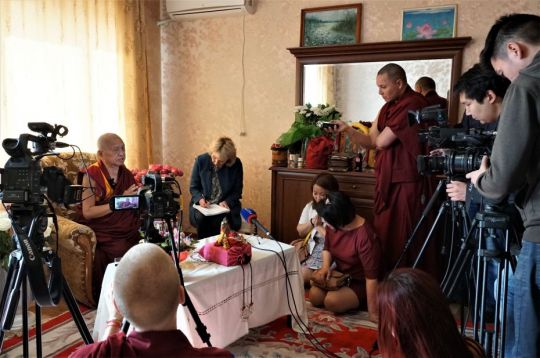
Lama Zopa Rinpoche at a press conference with all the media of Elista, Kalmykia, Russia, May 2017. Photo by Ven. Lobsang Sherab.
Watch four short YouTube videos of the Kalmyk cultural performances attended by Rinpoche here:
https://youtu.be/nxyYToloWS8
https://youtu.be/Genb0XRa_vM
https://youtu.be/l9PHu5XyoAw
https://youtu.be/vbuNnAVvo5k
See more photos from Rinpoche’s visit to Kalmykia in this new FPMT photo gallery:
https://photos.app.goo.gl/hSL4N47TdtX93ioPA
Read about Telo Rinpoche and the restoration of Buddhism in Kalmykia here:
https://fpmt.org/mandala/archives/mandala-for-2016/january/helping-buddhism-strengthen-and-grow-in-russia-an-interview-with-telo-rinpoche/
and here: https://fpmt.org/wp-content/uploads/sites/2/2008/12/Kalmykia.pdf
Lama Zopa Rinpoche is the spiritual director of the Foundation for the Preservation of Mahayana Tradition (FPMT), a Tibetan Buddhist organization dedicated to the transmission of the Mahayana Buddhist tradition and values worldwide through teaching, meditation and community service.
- Tagged: kalmykia, lama zopa rinpoche, russia, telo rinpoche, video, video short
5
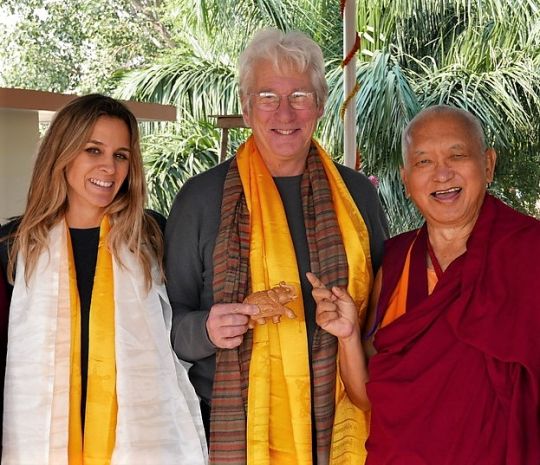
Lama Zopa Rinpoche with Richard Gere and Alejandra Silva at Root Institute, Bodhgaya, India, January 2017. Photo by Ven. Roger Kunsang.
Can our relationships help us progress on the path?
Lama Zopa Rinpoche says yes! Here is what he has said about relationships: “You should consider having a relationship to be an opportunity to practice Dharma … In particular, you should make sure that being together with someone becomes a cause of enlightenment by keeping in mind the motivation of bodhichitta. You should cherish, serve, and dedicate your life to your partner in the same way that you aspire to do for all sentient beings.
“You can use your relationship to practice morality by, for example, observing the five lay vows of abstaining from killing, stealing, adultery, lying, and mind-altering substances. Likewise, having a partner provides an opportunity for you to practice the other five perfections of giving, patience, perseverance, concentration, and wisdom. If you can do this, they will give you enlightenment …
“You can also think about your partner [like this]: ‘I have received every happiness experienced throughout beginningless lives from this person.’ Just that kindness is unimaginable, but on top of that, you also receive all your future happiness from them … Thinking in this way, the conclusion is that your partner is the most precious, most dear, and most kind person in your entire life.”

Flowers at Lama Zopa Rinpoche’s house at Buddha Amitabha Pure Land, Washington State, US, October 2016. Photo by Ven. Roger Kunsang.
Rinpoche added, “You should also keep in mind that in past lives, your present partner was your mother … By recognizing the vast kindness you’ve received from them, you will come to see yourself as their servant. Thinking in this way, your living together will become an opportunity to practice Dharma. With the attitude that the other person is most precious and kind, every single action you do will become a means of collecting extensive merit. If you also act with bodhichitta, you will collect limitless skies of merit and your actions will become the cause to achieve enlightenment for the benefit of all sentient beings. By thinking, ‘I am going to offer service to this person who is a most precious sentient being,’ you will collect a huge amount of merit every day and also purify defilements collected throughout beginningless lives. Since you will constantly create the cause for the biggest success—full enlightenment for all sentient beings—your life will be filled with happiness and hope.
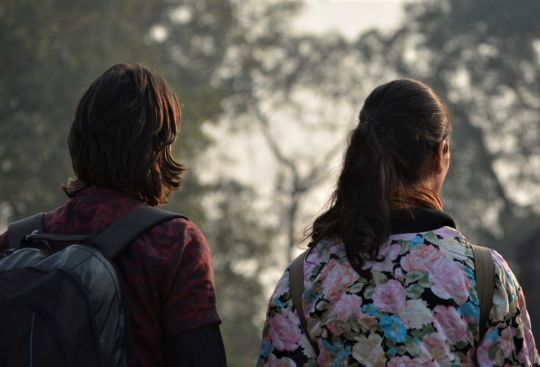
Ösel Hita and Indila Dora at Nalanda Monastery, India, January 2017. Photo by Kunchok Gyaltsen.
“When trying to understand the things that happen in a relationship, you need to take past karma into account … If you always remember to relate events to karma by thinking, ‘This is my karma’ and ‘This is their karma,’ a potential problem doesn’t even become a problem because you accept the situation. It does not bother you and there is peace in your heart.”
In conclusion, Rinpoche emphasized, “If you are able to make use of all your relationships to practice Dharma, you will lead a very healthy life … By thinking in the ways that I have explained here, you will be able to fully enjoy life. You will find satisfaction and fulfillment and you will experience inner peace and happiness.”
Rinpoche talks more about relationships in the video below.
Watch Rinpoche talk on YouTube about what matters for good relationships:
https://youtu.be/aU0-1IyPVvE
https://youtu.be/aU0-1IyPVvE
Find the complete teaching on making relationships meaningful:
https://www.lamayeshe.com/article/chapter/2-making-relationship-meaningful
See more videos of teachings by Lama Zopa Rinpoche at Rinpoche Available Now:
https://fpmt.org/media/streaming/teachings-of-lama-zopa-rinpoche/
Lama Zopa Rinpoche is the spiritual director of the Foundation for the Preservation of Mahayana Tradition (FPMT), a Tibetan Buddhist organization dedicated to the transmission of the Mahayana Buddhist tradition and values worldwide through teaching, meditation, and community service.
- Tagged: bodhichitta, lama zopa rinpoche, relationships, video
30
On his recent trip to Nepal, Lama Zopa Rinpoche visited the Maratika Caves, an important holy site associated with Padmasambhava (Guru Rinpoche).
Lama Zopa Rinpoche has visited Maratika on pilgrimage before and spoken about how good it is to do practice there. There are a number of caves in the area but the main cave for pilgrims is the Maratika Treasury Cave. It is here that Guru Rinpoche, with Mandarava, is said to have achieved immortality through the practice of Amitayus. In the main cave, there is a long-life vase (Tib. tse bum) made of stone, which Amitayus is said to have placed on the heads of Guru Rinpoche and Mandarava to bestow immortal life. This vase is the most holy object at Maratika. The cave also contains many self-created (Tib. rang jung) images and syllables. As well, it is considered that many spiritual treasures are hidden there. Texts say, for example, that Buddha Amitabha taught the eighteen tantras of long life at the request of Avalokiteshvara; dakinis wrote these down in symbolic script using melted lapis lazuli on golden paper, put them in a box made of five precious jewels, and concealed them at Maratika.
In 2009, Rinpoche shared the following about Maratika:
“This place, which is called Maratika, is greatly blessed, as the great master Padmasambhava meditated here on Amitayus (the long life deity) and actualized the state of deathlessness (the siddhi of immortal life). Apart from other lamas, the great Kyabje Trulshig Rinpoche [did] long life retreat every year here for His Holiness’s long life, which also greatly blesses the place. Especially, according to His Holiness the Dalai Lama, due to this accumulation of white virtue, just through seeing, hearing, remembering, and touching this place, the two obscurations of beings will quickly be purified, one will be looked after by the all-knowing one (the great master Padmasambhava) from Urgyen, and easily attain the state of omniscience. This holy place has many more infinite blessings than just explained, and every sick and afflicted being should go there.”
In 2016 while visiting the cave, Rinpoche translated a requesting prayer to Maratika, which has just been made available by FPMT Education Services. During Rinpoche’s 2016 pilgrimage to Maratika, Rinpoche received from Khenpo Gyurme Thegchog Gyaltsen a prayer he had composed called “A Requesting Prayer to Maratika: The Source of an Ocean of Siddhis.” Rinpoche translated this prayer into English and FPMT Education Services has recently published it. According to Ven. Sarah Thresher, who edited the English translation, the prayer “is a concise guide to the holy places and holy objects of Maratika in the form of a request. It also tells of the history and origin of the caves, the unique characteristics of the environment, the etymology of the place’s name, and the particular practices to be done.”
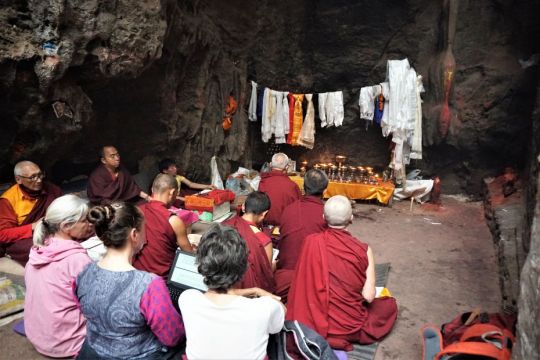
Rinpoche and others do practice inside the main Maratika cave, Nepal, April 2017. Photo by Ven. Lobsang Sherab.
Also while at Maratika recently, Rinpoche met with Ven. Tenzin Choegyal, the reincarnation of Ngawang Chöphel, known as the Maratika Lama, the main disciple of the Lawudo Lama, Rinpoche’s previous incarnation. Ven. Tenzin Choegyal is now seventeen years old and studies in Kathmandu at Shechen Monastery under Rabjam Rinpoche. Ngawang Chöphel’s son Lopön Karma Wangchug now looks after the monastery at Maratika.

Lama Zopa Rinpoche with Ven. Tenzin Choegyal, the reincarnation of Ngawang Chöphel, the main disciple of the Lawudo Lama, Maratika, Nepal, April 2017. Photo by Ven. Roger Kunsang.
In addition to doing prayers and practices at Maratika, Rinpoche blessed several goats liberated last year who are taken care of nearby. FPMT’s Animal Liberation Fund is contributing towards the goats’ care, and while at Maratika, Rinpoche offered additional funds for their food and other necessities for the coming year.
Watch a video here made in 2016 of Rinpoche leading an extensive motivation for the goats’ liberation before blessing them by chanting various mantras, reciting beneficial prayers, and tying blessed red cloth around their necks. Rinpoche ends the practice with several dedication prayers.
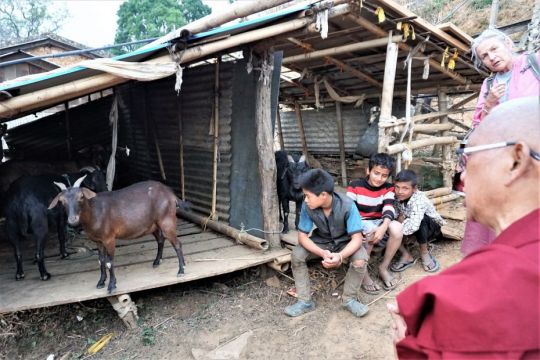
Rinpoche with liberated goats at Maratika, Nepal, April 2017. Photo by Ven. Lobsang Sherab.
“A Requesting Prayer to Maratika: The Source of an Ocean of Siddhis” can be found here:
https://shop.fpmt.org/A-Requesting-Prayer-to-Maratika-The-Source-of-an-Ocean-of-Siddhis-PDF_p_2919.html
Students interested in going on pilgrimage to Maratika Caves can contact Ven. Sarah Thresher through FPMT International Office for information and assistance.
Lama Zopa Rinpoche is the spiritual director of the Foundation for the Preservation of Mahayana Tradition (FPMT), a Tibetan Buddhist organization dedicated to the transmission of the Mahayana Buddhist tradition and values worldwide through teaching, meditation and community service.
- Tagged: lama zopa rinpoche, maratika cave, nepal, padmasambhava, pilgrimage
- Home
- News/Media
- Study & Practice
- About FPMT Education Services
- Latest News
- Programs
- New to Buddhism?
- Buddhist Mind Science: Activating Your Potential
- Heart Advice for Death and Dying
- Discovering Buddhism
- Living in the Path
- Exploring Buddhism
- FPMT Basic Program
- FPMT Masters Program
- FPMT In-Depth Meditation Training
- Maitripa College
- Lotsawa Rinchen Zangpo Translator Program
- Universal Education for Compassion & Wisdom
- Online Learning Center
- Prayers & Practice Materials
- Overview of Prayers & Practices
- Full Catalogue of Prayers & Practice Materials
- Explore Popular Topics
- Benefiting Animals
- Chenrezig Resources
- Death & Dying Resources
- Lama Chopa (Guru Puja)
- Lama Zopa Rinpoche: Compendium of Precious Instructions
- Lama Zopa Rinpoche: Life Practice Advice
- Lama Zopa Rinpoche Practice Series
- Lamrim Resources
- Mantras
- Prayer Book Updates
- Purification Practices
- Sutras
- Thought Transformation (Lojong)
- Audio Materials
- Dharma Dates – Tibetan Calendar
- Translation Services
- Publishing Services
- Teachings and Advice
- Find Teachings and Advice
- Lama Zopa Rinpoche Advice Page
- Lama Zopa Rinpoche: Compendium of Precious Instructions
- Lama Zopa Rinpoche Video Teachings
- ༧སྐྱབས་རྗེ་བཟོད་པ་རིན་པོ་ཆེ་མཆོག་ནས་སྩལ་བའི་བཀའ་སློབ་བརྙན་འཕྲིན།
- Podcasts
- Lama Yeshe Wisdom Archive
- Buddhism FAQ
- Dharma for Young People
- Resources on Holy Objects
- Ways to Offer Support
- Centers
- Affiliates Area
- Teachers
- Projects
- Charitable Projects
- Make a Donation
- Applying for Grants
- News about Projects
- Other Projects within FPMT
- Support International Office
- Projects Photo Galleries
- Give Where Most Needed
- FPMT
- Shop
Subscribe to FPMT News
Translate*
*powered by Google TranslateTranslation of pages on fpmt.org is performed by Google Translate, a third party service which FPMT has no control over. The service provides automated computer translations that are only an approximation of the websites' original content. The translations should not be considered exact and only used as a rough guide.Less desire means less pain.







